#vegas massacre
Text

i really like this guy
#i hope he dies#reexperience the bitter springs massacre#i started crying because of him btw (not because of anything about him actually)#i love you boone#did i already post this#bald ass bitch#craig boone#fallout new vegas#boone#fnv#benny gecko#dean's art#art#courier six#arcade gannon#raul tejada#vulpes inculta#veronica santangelo#rex#rex nv#new vegas#new california republic#ncr#i wish hed join the ncr and get shot
872 notes
·
View notes
Text
It’s my 20th birthday soon and my lovely friend had to just inform me that unfortunately my birthday card won’t be ready in time because trying to print it out broke her printer.
But what broke the printer exactly?


Attempting to print out 20 tiny Bennys.
#the 3 beheaded Bennys… a massacre.#happy birthday to me I guess??#what in the goddam???#benny fnv#fallout#fallout new vegas#fallout new vegas fanart#fnv#fnv shitpost#fallout shitpost
56 notes
·
View notes
Text
you know, for a series about reckoning with the sins of america's past, the conflict between different forms of governance and the pitfalls of blindly assuming the infallibility of american liberal democracy, and being forced to stop depending on modern technology and search for alternative solutions in an attempt to live in reparative relationship with scarred land or die trying, fallout sure doesn't have that many indigenous people in it, huh.
#the thoughtlessness of it is ESPECIALLY visible in fallout new vegas#like you're making a game about how the revived zombie of american liberal democracy massacres tribal peoples#you could maybe at least GOOGLE who's indigenous to the mojave and like. do something with that#like can you IMAGINE how crazy insane the arcade/enclave plotline would have gone if it like. involved mojave people he was consulting abou#medicinal properties of native plants#can you IMAGINE if the game was interested in using this lens to reckon with how imitating america's past also meant recreating the exploit#tion of indigenous people#especially given the entire plot centers around competing visions for the use of the area's natural resources#like come ON
56 notes
·
View notes
Text
The Supreme Court struck down the federal ban on bump stocks on Friday, legalizing a device that can effectively transform semiautomatic rifles into machine guns. Predictably, the court split 6–3, with the Republican-appointed justices carving a massive loophole in federal law at the behest of the firearms industry. Justice Clarence Thomas’ majority opinion is rooted in historical misrepresentations and utterly implausible manipulations of the statutory text. It enables future mass shooters to equip their AR-15s with an attachment that increases the rate of fire exponentially, to up to 800 rounds per minute.
Dahlia Lithwick and Mark Joseph Stern discussed the decision on Saturday’s episode of Amicus. They were joined by David Pucino, an expert in firearms law and legal director of the Giffords Law Center. Their conversation has been edited for length and clarity.
DAHLIA LITHWICK: Justice Thomas makes the claim that the Bureau of Alcohol, Tobacco, and Firearms did a complete 180° on how it viewed bump stocks, suddenly changing their minds after the Las Vegas massacre and deciding that, actually, they are machine guns. That’s just not true, right?
MARK JOSEPH STERN: This idea that ATF said bump stocks were 100% legal, then turned around in response to political pressure and said they were unlawful all along—that’s a misrepresentation of history. What really happened was that gunmakers were developing various tools to help make semiautomatic rifles fire at a higher rate. ATF looked at these and said some were potentially legal while others were not, on a case-by-case basis, without making a formal determination at the agency level. Some were snuck through under false pretenses as an accommodation for disability. And when ATF decided to take a holistic look at this issue after the Las Vegas shooting, it decided that, when bump stocks operate a certain way—basically, enabling automatic fire—they are illegal. That, to me, is doing exactly what an agency is supposed to do. ATF looked at the facts on the ground. It looked at its mandate from Congress. It looked at its own past decisions. And it harmonized them as best it could in accordance with what experts at the agency say the facts are. To see Thomas slander ATF as caving to political pressure, then using this charge to overrule the determination of ATF’s own firearm experts—it seemed to me the height of arrogance.
DAVID PUCINO: I think it’s important to remember that there was really careful work going on at ATF to make these determinations on a case-by-case basis. The agency was faced with a problem: Folks in the firearm industry were trying to get around the laws on the books. When an agency comes out and says, “This is what the law is,” the industry is going to try to get around it. And the agency has to decide if they’ll succeed. What’s really striking here is that ATF was doing that engagement, and the Supreme Court came in and usurped it here in a way that’s totally unworkable if you apply it beyond the favored political constituency of the gun industry. It’s absurd to have the Supreme Court putting all this work into deciding the mechanics of a firearm and whether it meets the statute and trying to overrule an agency that made those same determinations. That’s not a workable way to do government. If every difficult regulatory decision made in this country that might’ve gone one way or another goes up to the Supreme Court, that’s all the justices would ever be doing. You’d need a thousand Supreme Courts to handle it. The volume of work that comes out of the administrative state is not something that the Supreme Court can analyze in this way, at least not in any sort of reasonable manner, and I don’t think they would ever even pretend to. But what you have here is a particular, favored constituency that is bringing these questions. And then, all of a sudden, the court decides to drop everything and figure out how this gun works. Now, the way ATF does that is to sit down and actually look at the firearm. They’re going to bring in their experts and make those determinations. But the way the Supreme Court does it is they look at an amicus brief by the Firearms Policy Coalition and co-sign it.
LITHWICK: That’s the group that created the six graphics and a gif that Justice Thomas used to illustrate how semiautomatic rifles work. Why was it notable that he copied and pasted their material into a Supreme Court opinion?
PUCINO: The National Rifle Association is not what it used to be, and that’s created a gap. And what has gone into the gap are a bunch of further-right organizations that are trying to take the mantle of the NRA by being as extreme as possible. Foremost among them is the Firearms Policy Coalition. Friday was a real moment for them. It’s one of the most extreme groups; it uses extraordinarily violent rhetoric. And it’s putting out material that’s getting blessed by a majority opinion of the Supreme Court. You have to take a step back and look at where we are—I don’t think that’s anything you could imagine happening even 10 years ago.
LITHWICK: You’re both hitting on a big theme of this term, which is the Supreme Court making it impossible for agencies to do pretty much anything. And it seems awfully important when you have Clarence Thomas substituting his judgment for ATF’s with what Justice Sotomayor pointedly calls “six diagrams and an animation.” The majority was just like, I know everything, here’s a Peanuts comic strip. It seems as if Thomas was trying to explain his tortured interpretation to the public, to make it accessible, but eliding the agency’s own expert views in the process.
PUCINO: The idea that you can get the amount of expertise that goes into technical determinations made by ATF by simply looking at briefs and diagrams—I mean, just, no. Obviously not. The amount of time that even clerks, let alone justices, require to do a deep dive on these issues, the depth of understanding they’re going to need—it won’t come anywhere near that of an expert who’s working on this full time. This is their whole job. It’s what they’re trained to do.
STERN: You can really only justify Thomas’ reading, in my view, if you start from the conclusion that the bump stock ban is unlawful and work your way backward, butchering the text to mean something it just doesn’t. This isn’t how ordinary people use the English language and, as Sotomayor showed, it isn’t how members of Congress who voted on this law used English when they wrote it in 1934. If “textualism” can be deployed in such an underhanded and cynical way, I don’t think it’s really getting us anywhere. It’s just another pretext for the Supreme Court to reach whatever result it wants.
This is part of Opinionpalooza, Slate’s coverage of the major decisions from the Supreme Court this June. Alongside Amicus, we kicked things off this year by explaining How Originalism Ate the Law. The best way to support our work is by joining Slate Plus. (If you are already a member, consider a donation or merch!)
#us politics#news#slate#2024#Dahlia Lithwick#Mark Joseph Stern#David Pucino#amicus#podcasts#us supreme court#gun rights#gun control#bump stocks#ar 15#justice clarence thomas#bureau of alcohol tobacco firearms and explosives#las vegas massacre#Firearms Policy Coalition#national rifle association
14 notes
·
View notes
Text

JESUS CHRIST, ARCADE-
#Static screams into the void#Static plays FNV#Fallout New Vegas#Arcade Gannon#NOT THE GRANNIES ARCADE#I barely shot one- Arcade fucking massacred them with no hesitation.#And not even a minute after he bodies a freeside thug before I can even draw a weapon.#My guy has no chill-#(I mean I probably wouldn't if I just came back from having to deal with an underground vault of infected plant monsters.)#Average Wild Wasteland moment.#Anyways- not sure what quest to do next with these two#so I just poked around Cerulean Robotics in Freeside#since I think that it would be a super fitting home/base for Riley story-wise.#(He's a robotics nerd- he absolutely would set up shop there.)
16 notes
·
View notes
Text
3 notes
·
View notes
Text
GUN looking at every post since the update

On a separate note what fraction do you think the difference family members would choose
6 notes
·
View notes
Link
A Father's Promise, from Abramorama, presents the story of professional musician Mark Barden whose life changed instantly, when his son Daniel was murdered at Sandy Hook Elementary school, and the resilience to turn tragedy into hope.
#Janet Walker#Haute-Lifestyle.com#The-Entertainment-Zone.com#Newtown#Mark Barden#sandy hook promise#Mass Shootings#Uvalde#Las Vegas#parkland#columbine massacre#Virginia Tech#Michigan#Musicians#Music Industry#aurora#lewiston#colorado springs#Highland Park#San Bernadino#buffalo#Boulder#San Jose#dayton#virginia beach#how many more#march for our lives#common sense gun laws
2 notes
·
View notes
Text
I've reached a new level of sleep deprivation. I've had no idea wtf I was gonna post on my Tumblr but surprise it's gonna be shitposts and hyperfixtations.
★ABOUT ME!★
Heya, I'm Cameron! I'm not too sure what I'm gonna post yet, mostly art and reblogs, but feel free to ask for anything.
I want to write more (it's more of a hobby atp lol) so I'll be trying to do headcanons/ blurbs sooner or later.
I will NOT post NSFW (at least for now) and nothing like incest, proships/ pedophilia, or zoophilia.
Fandoms I'm in:
Don't Hug Me I'm Scared
Fallout (Bethesda)
Teenage Mutant Ninja Turtles (~2012)
The Umbrella Academy
Jujutsu Kaisen
Five Nights at Freddy's
Texas Chainsaw Massacre (both Sawyer & Hewitt)
House of Wax 2005
The Boy 2016
Marvel Avengers
Etc/ will add more!
That's all for now, I'll edit this sometime tomorrow, but rn I need serious sleep.
#about me#slasher fandom#house of wax#texas chainsaw massacre#fallout new vegas#fallout 3#fallout 4#rick and morty#fallout#dhmis#dont hug me im scared#tmnt#tua#the umbrella academy#jjk#jujutsu kaisen#fnaf#five nights at freddy's#marvel#avengers
2 notes
·
View notes
Text
Lucillius and Sarah stand at the crest of a hill on the outskirts of Alamogordo.
There’s a single steel plate marker attached to an angled concrete post, and a statue made of cast iron with several US Army servicemen operating a M2 Browning.
“Massacre of Parch’s Hill:
This hallowed ground witnessed a violent struggle in the Defense of Alamogordo on April 8’th 1982 AD, 5 years after the Great War.
Caesar’s Legion forces attempted to siege the capital of the Screaming Eagles, Alamogordo by attacking Holloman with a diversionary force, and routing it’s main force to actually siege the capital.
The 1’st Marines Division’s scout sniper detachment identified the siege before the trap was set, and the 18’th Artillery Division, 101st Airborne, 1’st Marines Infantry, Squadron 19, and 122’nd Aviation Company routed the battle and prevented the Legion from retreating in a fierce struggle in which none were killed but many were wounded with the Legion taking severe losses instead.
Many men and women suffered severe injury to protect the independence of the Eagles.”
“I can’t believe we did something so cruel as this.”
“Sarah, don’t get sappy on me. We did what we had to.”
#going off the belief thet howard added an extra 100 years to the fallout timeline#so yeah#fnv#fallout: new vegas#legion oc#fallout new vegas#fnv oc#fnv oc tribe#lorepost#massacre of parch’s hill#did you know: vulpes is absolutely terrified of the Eagles
1 note
·
View note
Text
HALLOWEEN MASSACRE Horror from female filmmaker Nicky Vega - trailer
‘Never bully again!’
Halloween Massacre is a 2024 horror film about bullying that leads to a horrific accident, a revenge killing and a sinister plan…
Written, produced, photographed and directed by Nicky Vega [as Nicky de la Vega] (The Halloween Maniac; Keep It in the Dark).
The Vega Pictures production stars Chandni Supawala, Julia Quayle, John Wedgwood, Ronnie Qureshi, Nicky Vega, Jake…

View On WordPress
#2024#British#Chandni Supawala#Halloween Massacre#horror#John Wedgwood#Julia Quayle#movie film#Nicky Vega#Ronnie Qureshi#trailer
0 notes
Note
pspsps... if you're playing new vegas on pc i HEAVILY recommend you download the benny returns mod <3
silly man companion that you can bring on ur travels (also flirts with u and makes stupid comments every few minutes)
ANON I AM SCREAMING I AM ON CONSOLEEEEEEEEEEE
genuinely, even the thought of this mod existing has made me so happy though!!!!
#my silly man <3#genuinely. do i just buy another copy on pc to have this mod#anon i want good things for you today#ask#it makes me so happy that others love him like i do#i'm playing with my friend and he killed my boy :( he massacred my boy :(#playing fallout new vegas#edit: i feel the need to make clear that my friend and i are playing together separately#my benny is totally fine! his benny though... 😬
1 note
·
View note
Text
silent carnival | ln4, op81

i will just leave this here without any particular comment. im glad that the las vegas is over and im even more glad that lando is okay. anyway, please enjoy it as always!
summary: lando crashed and went to the hospital, y/n and oscar coming to the rescue
warnings: nothing i think
pairing: lando norris x fem!mclarendriver x oscar piastri

The prevailing silence in the car was almost deafening, even the radio didn't dare to hum songs. The only audible sound was the quiet engine working at full throttle, ready to reach the destination as quickly as possible.
Y/N and Oscar sat next to each other in the back seat, gazing at the night landscapes illuminated by fiercely glowing neon lights. Neither of them was in the mood for conversation. The atmosphere was truly worse than gloomy.
Las Vegas was way much more than intense. The city pulsated with nightlife, decidedly more than any other place where Formula 1 had the pleasure to visit. That's why the silence that surrounded the McLaren drivers was quite shocking. However, this silence was entirely justified. It emerged when the orange car with number four on it submerged in sparks and concluded its disastrous ride in the barriers. Right then, all of Las Vegas froze; right then, the entire McLaren garage held its breath.
When the taxi parked at the hospital driveway, the pair quickly stepped outside and headed towards the entrance. After talking to the woman in the reception point and facing temporary difficulties finding the right room, they humbly sat on chairs in front of it. They had to wait until the tests were completed and the doctors left the room, allowing them to come in.
Seeing Y/N nervous, Oscar wordlessly embraced her, providing comfort. She closed her eyes and leaned on his shoulder, knowing well that she wouldn't calm down until she saw Lando with her own eyes.
After some time, when two doctors and a nurse left, the couple entered the room. Lando was genuinely surprised to see his friends, but he smiled seeing them.
The girl quickly approached the bed, ready to hug him, but she hesitated and lowered her outstretched arms, not wanting to cause him unnecessary pain. However, Lando pulled himself up a bit, reaching out to her and allowing the embrace. Oscar exchanged a reassuring look with his friend, smiling at him encouragingly. He sat on the bed and also hugged Lando, soothingly patting his back.
"You gave us quite a scare," Y/N murmured, still holding him tightly.
"It looked worse than the actual outcome it brought," he replied.
After some time, she pulled away and sat beside him, scrutinizing him carefully. Fortunately, there were no signs of serious injuries, just a few bruises and bumps.
"Thank goodness you're okay," Oscar said, glancing at him. However, Lando didn't seem overly comforted.
"Maybe I'm fine, but I completely fucked the car. I'd rather something happened to me than—" "Don't even say that," Y/N quickly interrupted him, scolding him with her gaze.
"Our cars have been total crap for a few races now, so I think you did a favor to the factory people," Oscar remarked with a reassuring smile, lifting Lando's spirits a bit, although he still shook his head.
"Total massacre. At least you fought for our honor," Norris said, looking at the aussie.
"Fought is an understatement. Oscar was ready to throw hands," the girl laughed at his comment.
"Maybe it's for the best, considering how much of a disaster the track was. And you just crashed and hopped into the warm and comfy ambulance without giving a fuck—lots of space, delicious, perfectly chilled water, phew," Piastri joked, maintaining a serious demeanor.
Lando chuckled, nodding in agreement. "I'm glad this race is behind us," Norris admitted with a sigh, wincing as he adjusted himself on the bed. "It's just a shame about the outcome."
"It doesn't matter," Y/N said, resting her head on his shoulder. "The most important thing is that you're okay."
"Since I'm fine, you shouldn't waste time here," Lando said, looking at his friends. "This is our last night in Vegas; I'd go for a wild party if I were you."
"Oh c'mon, fuck Vegas," Oscar cut in, shaking his head.
"I can't wait to leave this place," Y/N admitted, taking out her phone "I'll order us some champagne, what do you think? We need to toast to this cursed city."
"I'm a hundred percent in," Oscar nodded.
"I hope no one will be mad at us for a little party here," Y/N said, dialing a number.
"It's an open party, the McLaren house is open to everyone," Oscar added.
And as they said, so they did. Shortly after, three bottles of champagne appeared in the hospital room and each of the trio could swear that the shared evening was better than any party.
At some point, Lando stopped thinking about the past race and the unfortunate crash. His thoughts departed from that incident; he didn't even feel the pain of his bruised body as he held a perfectly chilled bottle of champagne in his hand. He couldn't also contain his smile as his friends danced in the middle of the hospital room, singing a song in his honor. At that moment, Lando was genuinely happy and understood that to feel this way, all he needed was the company of these two, who would do anything for him.
#f1 imagines#f1 one shot#formula 1#op81#ln4#f1#lando norris#oscar piastri x reader#lando norris x reader#lando norris x reader x oscar piastri
513 notes
·
View notes
Text

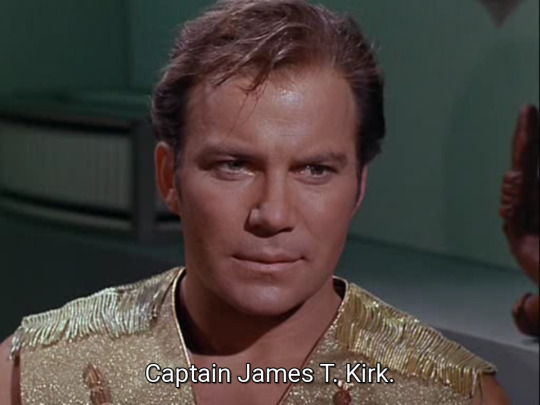

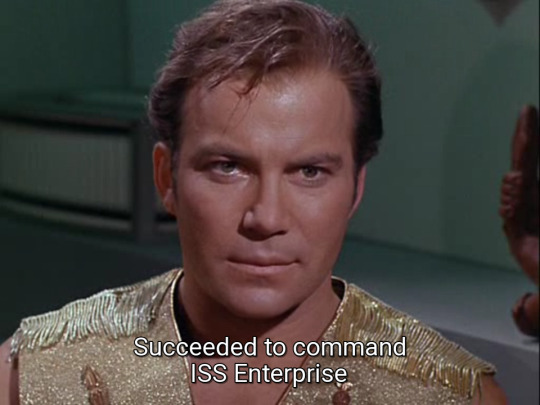



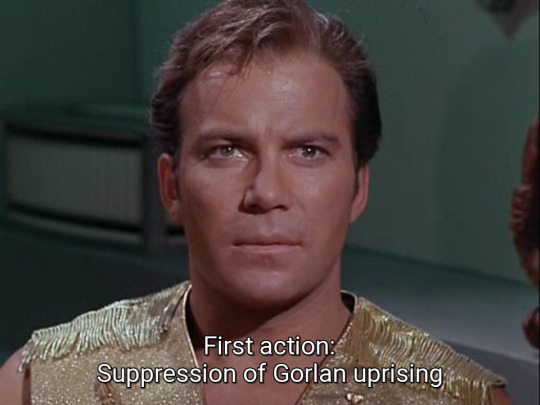
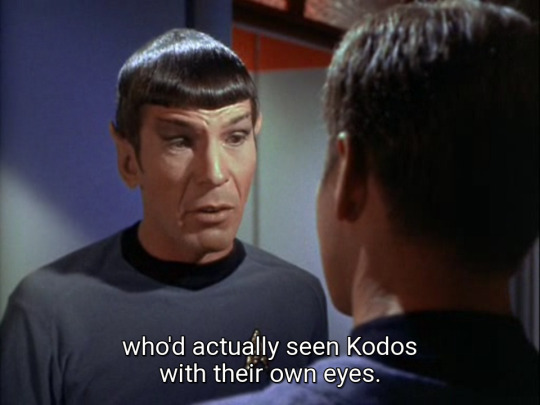

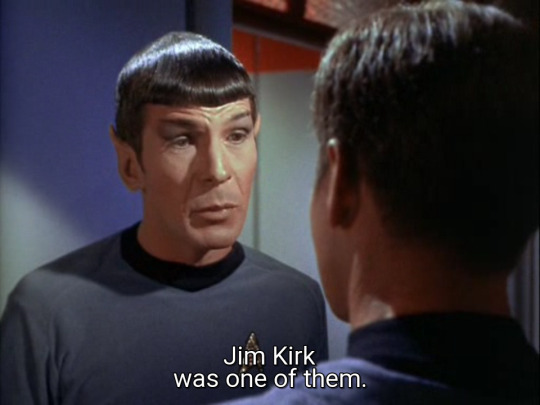
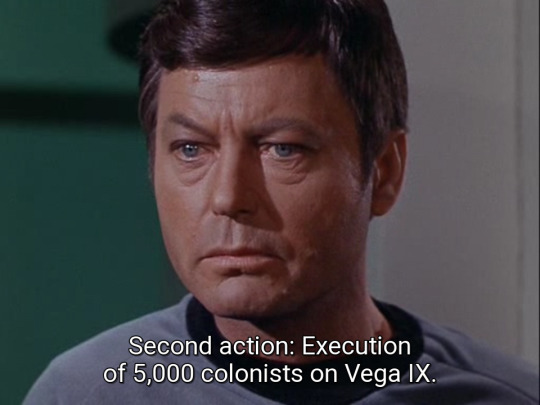
The Conscience of the King + Mirror, Mirror
It's interesting to note that Bones is the link between these two scenes. Spock gives him the information about Tarsus IV since Jim refuses to speak of his past. In the Mirror Universe, Bones is with Jim when they learn that Mirror Kirk is responsible not only for killing his captain and destroying a whole planet but that this Kirk has killed 5,000 colonists on a planet named Vega IX. And to have the camera show Bones' reaction to Vega IX instead of Jim's response? What a way to recall The Conscience of the King and place the audience with Bones as they hear news of a massacre that chillingly parallels Tarsus IV.
Also, I used these scenes not just for the exposition but also because there's a delightful swapping of both the placement of Kirk's name in the scenes alongside the role reversal. In other words, in The Conscience of the King, the scene reveals that Jim Kirk is the survivor of a massacre, and it ends with the use of his name, albeit in its diminutive, nickname form (Jim rather than James). Whereas in Mirror, Mirror, the scene begins with Jim's full name and rank title, and it reveals that he is the one committing the massacre. The two scenes not only recall each other, but they show the other's reverse as if looking through a mirror.
#star trek tos#the conscience of the king#mirror mirror#jim kirk#tarsus iv#'star trek tos is a fun sci fi show' i tell myself as i post things like this#but the usual caveats apply: word choice matters. camera framing matters. etc.#details details details my beloved#tos parallels#trek meta#galaxy brain posting
198 notes
·
View notes
Text
BY MARK JOSEPH STERN
The Supreme Court’s conservative supermajority carved a huge loophole into the federal prohibition against machine guns on Friday, striking down a bump stock ban first enacted in 2018 by the Trump administration. Its 6–3 decision allows civilians to convert AR-15–style rifles into automatic weapons that can fire at a rate of 400–800 rounds per minute. One might hope a ruling that stands to inflict so much carnage would, at least, be indisputably compelled by law. It is not. Far from it: To reach this result, Justice Clarence Thomas’ opinion for the court tortures statutory text beyond all recognition, defying Congress’ clear and (until now) well-established commands. As Justice Sonia Sotomayor explained in dissent, the supermajority flouts the “ordinary meaning” of the law, adopting an “artificially narrow” interpretation that will have “deadly consequences.” This Supreme Court will be squarely at fault for the next mass shooting enabled by a legal bump stock.
Friday’s decision, Garland v. Cargill, is not a Second Amendment case. The plaintiffs do not (yet) argue that the Constitution guarantees a right to own bump stocks. Rather, they claim that the Trump administration stretched existing law too far when it outlawed bump stocks following the 2017 Las Vegas shooting. The gunman committed that massacre with the assistance of a bump stock, allowing him to murder 60 people in 10 minutes from 490 yards away, the deadliest single-gunman mass shooting in U.S. history. To use this device, a gunman attaches it to his AR-15, then holds his finger on the trigger and leans forward to maintain pressure on the bump stock. A semiautomatic requires the shooter to pull the trigger to fire each round. When done correctly, by contrast, “bump firing” can then unleash a spray of bullets without repeated pulls of the trigger, and at the rate of an automatic weapon. This barrage is audible in many videos of the Las Vegas shooting; victims were mowed down in rapid succession because the bump stock enabled nonstop fire.
For years, the Bureau of Alcohol, Tobacco, Firearms, and Explosives had been monitoring these devices; the agency found some unlawful, depending on their precise mechanisms, but did not take a formal position overall. The Las Vegas shooting prompted ATF to conclude that bump stocks transform semiautomatic rifles into machine guns, rendering them illegal under a long-standing federal statute. That’s because this law bans “any part designed and intended solely and exclusively” for “converting a weapon into a machinegun.” And a “machinegun” is defined as any firearm that fires “automatically” by “a single function of the trigger.” After extensive deliberation, ATF found that bump stock–equipped rifles do exactly that.
Now the Supreme Court has decided that it understands firearms better than the ATF. Thomas’ majority opinion reads like the fevered work of a gun fetishist, complete with diagrams and even a GIF. The justice, who worships at the altar of the firearm, plainly relished the opportunity to depict the inner workings of these cherished tools of slaughter. (It’s no surprise that he borrowed the images from the avidly pro-gun Firearms Policy Foundation.) To reach his preferred result, Thomas falsely accused ATF of taking the “position” that bump stocks were legal, then “abruptly” reversing course after the Las Vegas shooting. This account is dead wrong: ATF took a careful, case-by-case view of different bump stock–like devices as gunmakers developed them, deeming some permissible and others unlawful. The gun industry pushed these devices into the mainstream by deceiving ATF about their purpose; in one case, for instance, a manufacturer won approval from the agency by claiming a bump stock was designed to accommodate people with limited hand strength—then turned around and marketed it as the next best thing to a machine gun.
After wrongly accusing the agency of a politically motivated about-face—and using this charge to discount its expertise and authority—Thomas adopted a highly technical interpretation of the statute that does not align with its text. A “single function of the trigger,” he wrote, does not mean a single pull of the trigger, but rather a complete “cycle” of the spring-loaded hammer inside the gun. Because the hammer (rapidly) resets to its original position between shots, Thomas concluded, “bump firing” involves more than “a single function of the trigger.” And because the shooter must “actively maintain” a particular stance to put pressure on certain parts of the weapon, the justice wrote, the resulting fire is not truly “automatic.”
Sotomayor’s dissent, joined by Justices Elena Kagan and Ketanji Brown Jackson, rebuts this butchering of the text in a tone that toggles between scathing and mournful. She pointed out that when Congress first banned “machineguns” in 1934, their “internal mechanisms” “varied enormously”: Some used triggers, others buttons; some relied on the shooter’s backward pressure on the weapon, while others harnessed the recoil produced by a bullet’s discharge. “To account for these differences,” Sotomayor wrote, “Congress adopted a definition” that encompassed all guns that fire continuously without any need for the shooter to reengage the trigger. That had, until Friday, been the ordinary meaning of “automatic” fire. Extensive records of congressional debate around the 1934 bill confirms beyond a doubt that lawmakers intended to codify this definition. And “evidence of contemporaneous usage overwhelmingly supports that interpretation,” too.
Yet the Supreme Court has now replaced this near-century-old understanding with a narrow, highly technical one that lacks a basis in statutory text. By doing so, Sotomayor noted, the majority “arrogates Congress’s policymaking role to itself.” Its indefensible decision “eviscerates Congress’s regulation of machineguns,” “enables gun users and manufacturers to circumvent federal law,” and “hamstrings the government’s efforts to keep machineguns from gunmen like the Las Vegas shooter.”
And why? Yes, a deep current of gun fetishism runs through Thomas’ opinion. But so, too, does an arrogant skepticism of federal agencies like ATF and the experts who staff them. The majority snidely casts aside ATF’s interpretation in favor of its own amateur conception of how a true machine gun operates. In the process, it does serious damage to American democracy, disobeying a congressional mandate and overriding a decision by the executive branch, which—unlike the judiciary—is accountable to the people.
Yes, Congress can go back to the drawing board and enact a broader law that sweeps in bump stocks. (It won’t, because Republicans will block any such proposal.) That’s what Justice Samuel Alito advised in a concurrence on Friday, urging lawmakers to patch the loophole that he helped to create. But Congress shouldn’t have to correct the Supreme Court’s mistakes. On the rare occasions when it can overcome gridlock, the legislative branch should not have to expend time fixing laws that SCOTUS broke. And the rest of us should not have to worry that the justices, cocooned in their ever-expanding security details, will cavalierly subject us to the prospect of mass slaughter. To the conservative supermajority, this case is about word games and diagrams. To the future victims of bump stock–enabled shootings, it is a matter of literal life and death.
#us politics#news#republicans#conservatives#us supreme court#gun rights#gun control#gun violence#bump stocks#bump stock bans#ar 15#justice clarence thomas#Garland v. Cargill#second amendment#las vegas massacre#bureau of alcohol tobacco firearms and explosives#Firearms Policy Foundation#2024#mark joseph stern#op ed#slate
8 notes
·
View notes
Text
When The Owl House first came out, there was a lot of discussion surrounding how King could potentially be Bill, with the most common theory being that Bill had somehow been reincarnated into King by the Axolotl. After all, not only does Alex Hirsch voice both of them, but the voice he uses for King is very similar to the voice he uses for Bill. (Very similar, but not the exact same; apart from not having the voice distortion, King's voice is higher pitched. King's voice is basically Bill's voice before Bill hit puberty, lmao.) Apart from that, both King and Bill are demons; King had an obsession with ruling, power, and conquest; King has yellow sclera; and, well, people were desperate for connections between Gravity Falls and The Owl House, to the point where I actually did end up pretty annoyed for awhile that people weren't letting The Owl House stand on its own two feet and were instead treating it like a sequel show. (Though there are actual, canonical connections between them now, the most notable being that Eda married Stan for less than 24 hours in Vegas so that she could rob him blind, lmao. He still thinks fondly of her to this day, as he should.)
I bring this up because I never really subscribed to this theory, or thought very much of it . . . until now. It's not that I think the theory is more plausible now, but more that I think that the idea holds a sort of poetic beauty to it now, if it was true. (Which again, I don't think it necessarily is, but more that it's a nice "what if" to think about.) And the reason for that comes from information that we gained from The Book of Bill, along with additional information that we've now gained from the website, along with how King's story arc developed and played out in The Owl House. (So, spoilers for that show, the new book, and the website if you haven't kept up with any of that.)
Essentially:
It's been heavily implied for years now (to the point where, in my personal opinion, it was known, but to be safe I'm saying heavily implied) that Bill destroyed his home dimension. In the show, Bill says that he "liberated" his home dimension, and when he brings it up, there is fiery imagery around him that is similar to the rift that opens in the sky to link Gravity Falls to the Nightmare Realm during Weirdmageddon. Then, in one of the spinoff books, when Dipper asks the Axolotl about Bill, the Axolotl says, "Saw his own dimension burn [. . .] blame the arson for the fire." Considering that Bill said that he "liberated" his dimension with fire imagery, and the Axolotl says that he saw his dimension burn (and blames the arson, rather than the arsonist for the fire) . . . the conclusion can easily be drawn that Bill's "liberation" was actually "destruction." Which makes sense, when you remember what he wanted to do to Earth during Weirdmageddon.
Nonetheless, we have had that confirmed now thanks to The Book of Bill and the website. We know that when Bill tries to recant what happened to his dimension, there is a loud ringing in his ears and he blacks out; we know that he looks "more distant than [Ford] had ever seen him" when he tries to recount the story to Ford (implying dissociation; we know that he told his henchmaniacs the "liberation" story and that he freaks out when Time Baby tries to speak openly about what actually happened and who actually caused it; and we know that, during his therapy sessions in the Theraprism, when the therapist tries to turn the discussion to his parents, he shuts down discussion altogether. (And also only draws red and blue triangles during his art sessions, implying that may be what his parents looked like.)
So we know that: Bill destroyed his own dimension, that he's the sole survivor of the massacre, that he was severely traumatized by this (because he didn't intend to massacre his entire people, he honestly was trying to help them see what he could see -- the third dimension) and that he just handled his trauma in the worst possible way, particularly since he did not have anyone left to give him a support system. A billion years without a proper support system or any form of healing, sinking further and further into denial, rationalization, and detachment (outlined on Bill's page on morality as his tools of the trade), lying until his lies were no longer lies to himself, made Bill into the monster he is today.
But then the Pines family defeated him (thanks to Stan), he invoked the name of the Axolotl, and got sent to the Theraprism. He hates it there, and he is so deeply entrenched in the lies-he-no-longer-recognizes-as-lies that he is not making any progress. As Alex said at one of the Barnes & Noble Q&As, what Bill really needs is to actually be honest with himself, but it's unknown if he will ever be able to do that. Until he can do that, the hope of him actually making progress at the Theraprism is nil.
But here is the thing about the Theraprism. Well, here are the two things about the Theraprism:
The first is that we are told that the Theraprism is a place specifically devoted to reincarnation. The reason why the "King is reincarnated Bill" theory was popular before was mostly due to the reasons I mentioned above, but also because of another line in the Axolotl's poem: "A different form, a different time." People understood this to mean reincarnation, and it's easy to see why. But for me personally, I always found it a bit strange that the Axolotl would simply let Bill reincarnate simply by calling out for help. Would that really be all it took for the Axolotl? True, the Axolotl is the god of this universe, and Jesus (from how I understand it) is all about "accept me as your savior and you're immediately absolved of all sins," but I also felt that was just too easy of a Get Out of Death Free card for Bill. It was a very clean getaway, considering everything.
But The Book of Bill makes it evident that isn't the case. As it is described by the Theraprism employee in the book:
"Here at the Theraprism, we believe death can be the beginning of a new life. With good behavior, former wizards, world-eating titans, and even Mr. Cipher have many exciting options for reincarnation -- perhaps as a newt, shrimp, or a cloud of fungal spores!"
The Axolotl also made this clear to Bill (though Bill misunderstood entirely:
"You cannot regrow through denial. You'll have to face my hardest trial. See my program to the end, then you may yet live again. You're getting what you need the most; one way to absolve your crimes, to change your form will take some time."
Now, many of you are probably thinking: a baby titan from the Boiling Isles is a huge leap from newts, shrimp, and fungal spores. I would agree with you; it seems that the Theraprism does tend to pick very lowly life forms for the big bads they rehabilitate to reincarnate into. But here are the reasons why I think it would be poetic if it were King, and therefore why I like to think that it would be nice if this were the case:
Like Bill, King is the last of his kind. Unlike Bill, this is through no fault of King's own; the other titans were wiped out before King even hatched, and King's father had to hastily inscribe runes to protect him from the titan hunters (or archivists?) so that they couldn't find and kill him as well by destroying his egg. Nonetheless, King is the sole survivor of a genocide and this is something that weighs heavily on him and influences his character arc in a big way in the second half of the show. The fact that he doesn't know what he is lends struggle to him trying to discover who he is. Yes, he's in a family of misfits, but Eda and Luz know what they are and who they come from. King doesn't have that. King has no basis for what he is, or why he was abandoned -- none of it. And then when he does finally start to get answers, it's to learn that his people were massacred in a genocide; that there are people still out there who want to kill him; that he is going to grow to be a deity-like figure, that he'll outlive those he loves . . . King is a child of about eight-years-old, but he has so, so much weighing on him already.
But where Bill accidentally destroyed his dimension and killed everyone in it, and then was crushed under the weight of that trauma because he was left alone and covered in blood, King did have that family of misfits to support and love him through it all. He was still burdened by the fact that he didn't know what he was or where he came from, but Eda, Hooty, Luz, and eventually Lilith gave him unconditional love and a home and support to figure all of that out, to the point where it was King's idea to be formally adopted by Eda and change his name to King Clawthorne. And while he will eventually outlive them all, he made a friend in The Collector who is also immortal, so he'll never be truly alone.
Essentially, what I'm getting at here is: there are parallels in Bill's and King's story, now that we know Bill's backstory. They aren't the exact same, especially since King was not responsible for what happened to the other titans. But there are still parallels that can be made. But whereas things ended as badly as they could possibly end up for Bill, King's story had a much better ending. So if we imagine that Bill was reincarnated as King, then it is almost like he got a do-over. Like he was put in a similar situation, but this time he was found by a new adoptive mother who raised him with love and care, and got an adoptive big sister, and owl tube house mate, and aunt, as well as a ton of friends. He suffered trauma, but this time he didn't have to suffer it alone, and was able to handle it in a much better, much healthier way. Yes, he's an all-powerful demon (or at least, he will be someday, when he grows into an adult). But this time he isn't going to be causing any apocalypses, or delighting in any mortal suffering. This time, things are going to be different for him, because his soul completed the Axolotl's program in the Theraprism and he was able to reincarnate for that second chance.
(And if you're thinking, "But The Owl House doesn't take place that long after Gravity Falls, so how is that possible?" Well, the Theraprism exists outside of time and space, so it doesn't matter how many millennia it takes for Bill to complete the program. He literally has all the time in the multiverse.)
So I'm on board with this theory now. Again, I do not think it's canon. But it's a nice idea, and one that I think has a poetic sweetness to it. No one has to agree, of course, but that's just my take on it.
#gravity falls#the owl house#bill cipher#king clawthorne#the book of bill#thisisnotawebsitedotcom#the axolotl
119 notes
·
View notes